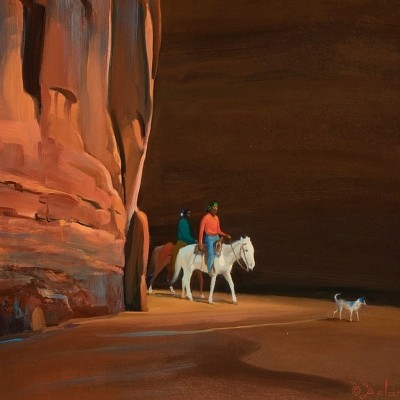Gilbert Munger, Mount Tamalpais with a View of San Francisco Bay, ca. 1870
About Seller
932 Railfan Road
Santa Fe, NM 87505
United States
Boasting the third-largest art market in the United States, Santa Fe has long been a destination for new and seasoned collectors. Located in the heart of the city’s historic downtown, and organized in conjunction with the Gerald Peters Gallery, the Santa Fe Art Auction is the Southwest’s premier ann...Read more
Two ways to bid:
- Leave a max absentee bid and the platform will bid on your behalf up to your maximum bid during the live auction.
- Bid live during the auction and your bids will be submitted real-time to the auctioneer.
Bid Increments
| Price | Bid Increment |
|---|---|
| $0 | $100 |
| $2,000 | $250 |
| $5,000 | $500 |
| $10,000 | $1,000 |
| $20,000 | $2,500 |
| $50,000 | $5,000 |
| $100,000 | $10,000 |
About Auction
Nov 6, 2021
The Santa Fe Art Auction is delighted to present the 29th Signature Live Auction – the pinnacle of our calendar year. This year it brings together the very best of our diverse sale categories, including Native American, Spanish Colonial, Prints and Works on Paper, and fine American art. Santa Fe Art Auction info@santafeartauction.com
- Lot Description
Gilbert Davis Munger
(1837 - 1903)
Mount Tamalpais with a View of San Francisco Bay, CA (A Glimpse of the Pacific), ca. 1870
oil on canvas
A second-generation Hudson River School painter, Gilbert Munger grew up in Madison, Connecticut. When he was thirteen, his parents apprenticed him to the engraver William H. Dougal, who worked for the Smithsonian. Munger moved to Washington, DC, in 1850 and remained with Dougal for ten years, mastering the art of engraving and producing plates for publication in government reports. In Washington, Munger encountered a number of painters of the Old West including John Mix Stanley, with whom he became friendly. Inspired by their careers, Munger began to study painting independently in his free time and was soon intent on pursuing a career as an artist. The Civil War delayed his plans: Munger was employed by the Union Army in Washington where he worked on the city’s defenses. In 1866, however, he moved to New York City, established a studio in Manhattan, and began to exhibit at the National Academy of Design that year.
Still fascinated by the west, Munger finally traveled there in 1869. He joined Clarence King’s Geological Exploration of the 40th Parallel and visited the Uinta and Wasatch Mountains in Utah and the Cascades in Northern California, Oregon, and Washington. He returned west in 1872 and 1873, visiting Colorado, Idaho, Nevada, and Wyoming, and again in the summer of 1875. Although now traveling independently, Munger was still producing drawings and paintings for King on the promise of having a number of his works reproduced as chromolithographs in Systematic Geology, which was eventually published in 1878 with ten of Munger’s studies. During these years, Munger established San Francisco his home base where, along with Albert Bierstadt and Thomas Hill, he quickly became one of the premier California artists.
Munger spent much of the second half of his career abroad. He moved to London in 1877, bringing his western sketchbooks with him. These sketches served as the bases for numerous American scenes created for his new European market and sold with great success. In 1886, Munger moved again, this time to Paris. His time in France had a significant influence on his style as his realistic Hudson River School landscapes gave way to softer, brushier compositions in line with the Barbizon School. These paintings were well received and Munger was widely recognized for his efforts. He was honored with numerous awards, including the Chevalier of the Legion of Honor, and his works were avidly collected by institutions including the Royal Academy and the Luxembourg Gallery. Munger returned to the United States in 1893 but was unable to transfer his European success back to the United States. He settled again in Washington, DC, where he continued to paint, but he died in relative obscurity in 1903.
Munger completed the present painting around 1870 during his years spent in San Francisco. It has been suggested that the scene depicts a view from the top of Mt. Tamalpais, a prominent peak in Marin County just north of San Francisco. It is undoubtedly a view north along the Pacific coast taken the San Francisco Bay area. A letter of authenticity from Alfred C. Harrison Jr. accompanies this work.
24 x 42 in. (60.96 x 106.68 cm.), Frame: 38 1/2 x 56 1/2 x 3 in. (97.79 x 143.51 x 7.62 cm.)
Private Collection, New York
Literature:
Michael D. Schroeder, The Art of Gilbert Munger (The Gilbert Munger Website), Duluth, MN: Tweed Museum of Art, 1999, No. 270.The condition reports for the lots offered by Santa Fe Art Auction (SFAA) are provided as a courtesy and convenience for potential buyers. The reports are not intended to nor do they substitute for physical examination by a buyer or the buyer's advisors. The condition reports are prepared by SFAA staff members who are not art conservators or restorers, nor do they possess the qualifications needed for comprehensive evaluation. Each condition report is an opinion of the staff member and should not be treated as a statement of fact. The absence of a condition report does not imply anything as to the condition of a particular lot. Buyers are reminded that the limited warranties are set forth in the Terms and Conditions of Sale and do not extend to condition. Each lot is sold as-is.Condition
- Shipping Info
-
The Santa Fe Art Auction may, in its discretion and at a Buyer’s request, pack and ship items as directed by the Buyer. In such event, Buyer agrees to the following conditions:
- All such packing, handling and shipping is at the sole risk of the Buyer and the Santa Fe Art Auction shall have no liability for any loss or damage to such items, and
- Buyer shall pay all related expenses in advance. Buyer should allow four to six weeks for shipping from the date of the auction.
SANTA FE ART AUCTION IS PLEASED TO PRESENT THE FOLLOWING SHIPPING OPTIONS. PURCHASES SHALL NOT BE RELEASED UNTIL PAYMENT IS RECEIVED IN FULL.
_____ I would like to pick up my artworks from Santa Fe Art Auction.
Arrangements for pick up must be made within 2 weeks post sale via email or telephone. I understand that I may be liable for New Mexico Sales tax.
_____ I would like my artwork to be released to a third-party shipping company (selected below).
If I select this method of shipping, I understand I must sign and deliver to the Santa Fe Art Auction the Release and Insurance Waiver below.
The UPS Store
3201-C Zafarano Drive
Santa Fe, NM 87505
Telephone: 505-438-2427
store6324@theupsstore.com
PAKMAIL
369 Montezuma Avenue
Santa Fe, NM 87501
Telephone: 505-989-7380
Website: weshipsantafe.com.
Art Handlers LTD
1570 Pacheco St. Suite A-1
Santa Fe, NM 87505
Telephone: 505-982-0228
Other:
Company Name / Authorized Agent _____________________________
Address __________________________
Telephone __________________
E-mail ____________________
RELEASE & INSURANCE WAIVER
- I, ________________ ("Purchaser") have paid for and own the following art: Lot (s) # ________________ (hereinafter "Work(s) of Art").
- I want my Work(s) of Art shipped via this shipper: ___________ ("Shipper"). Santa Fe Art Auction ("SFAA") is hereby directed to release the Work(s) of Art to Shipper at SFAA's location in Santa Fe, New Mexico on a date stated in writing to SFAA by Purchaser.
- SFAA shall be released and discharged from any and all duties of care owing from SFAA to Purchaser and Purchaser hereby unconditionally waives any and all claims against SFAA.
- Purchaser acknowledges and agrees that SFAA, and any of their agents do not carry specific insurance for the Work(s) of Art listed. The Purchaser has agreed to arrange or cause to be arranged the insurance for the transit and handling of the property. SFAA shall bear no responsibility for the adequacy of the Purchaser's insurance.
- Upon delivery of the Work (s) of Art to Shipper, and at all times thereafter, Purchaser shall indemnify and hold SFAA harmless from and against any and all claims related to the Work(s) of Art, directly or indirectly, however such claims may arise.
- Purchaser affirms to SFAA that Purchaser has the authority to execute and perform this Release.
__________________________________________________
Buyers Signature Date
ADDENDUM: Request for Frame Removal
** I, _________________________ ("Purchaser") hereby request the following Lot(s) ______________ be removed from the frame by SFAA prior to release to my selected Shipper.
- Such service shall be provided to the Purchaser at a cost of $_____________ per Lot.
- The Purchaser shall hold harmless SFAA for any and all claim(s), for any loss or damage howsoever occurring, irrespective of negligence, including any claim expense or consequential loss while handling, removing from frame or uninstalling.
-
- Buyer's Premium



 EUR
EUR CAD
CAD AUD
AUD GBP
GBP MXN
MXN HKD
HKD CNY
CNY MYR
MYR SEK
SEK SGD
SGD CHF
CHF THB
THB

















